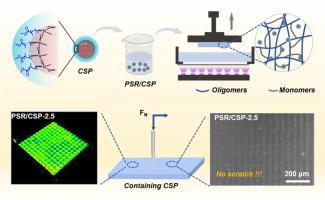Enhancement of scratch resistance properties on the surface of photocurable 3D printed models through the integration of polysiloxane core–shell nanoparticles
IF 8.3
2区 材料科学
Q1 MATERIALS SCIENCE, MULTIDISCIPLINARY
引用次数: 0
Abstract
Photocurable 3D printing technology has attracted widespread attention because of rapid formation speed and high printing accuracy, but photosensitive resin (PSR) materials with scratch resistance have become a difficult problem in 3D printing research. In this paper, polysiloxane core-shell nanoparticles (CSP) were prepared to achieve both reduced friction coefficient and enhanced mechanical properties. Compared with pure photosensitive resin, the 3D printed model with the optimal amount of 2.5 wt% CSP has a lower friction coefficient and wear rate, which are reduced by 77.6 % and 75.8 %, respectively, and the impact strength, tensile strength and elongation at break are increased by 25.7 %, 26.1 % and 40.1 %, respectively. The scratch resistance was evaluated by constant load scratch test and progressive load scratch test. The results showed that CSP significantly improved the scratch resistance of 3D printed models, and the penetration depth was continuously reduced from 175.5 μm to 128.3 μm under a load of 30 N. These findings indicate that CSP is a promising scratch-resistant additive for application, expanding the application range of photocurable 3D printing.

通过整合聚硅氧烷核壳纳米粒子增强光固化 3D 打印模型表面的抗划伤性能
光固化3D打印技术因成型速度快、打印精度高而受到广泛关注,但具有抗划伤性能的光敏树脂(PSR)材料却成为3D打印研究中的难题。本文制备了聚硅氧烷核壳纳米粒子(CSP),以达到降低摩擦系数和增强机械性能的目的。与纯光敏树脂相比,最佳用量为 2.5 wt% CSP 的 3D 打印模型的摩擦系数和磨损率分别降低了 77.6% 和 75.8%,冲击强度、拉伸强度和断裂伸长率分别提高了 25.7%、26.1% 和 40.1%。耐划伤性通过恒载划伤试验和渐进载荷划伤试验进行了评估。结果表明,CSP 显著提高了 3D 打印模型的抗划伤性,在 30 N 负载下,穿透深度从 175.5 μm 持续减小到 128.3 μm。
本文章由计算机程序翻译,如有差异,请以英文原文为准。
求助全文
约1分钟内获得全文
求助全文
来源期刊

ACS Applied Materials & Interfaces
工程技术-材料科学:综合
CiteScore
16.00
自引率
6.30%
发文量
4978
审稿时长
1.8 months
期刊介绍:
ACS Applied Materials & Interfaces is a leading interdisciplinary journal that brings together chemists, engineers, physicists, and biologists to explore the development and utilization of newly-discovered materials and interfacial processes for specific applications. Our journal has experienced remarkable growth since its establishment in 2009, both in terms of the number of articles published and the impact of the research showcased. We are proud to foster a truly global community, with the majority of published articles originating from outside the United States, reflecting the rapid growth of applied research worldwide.
 求助内容:
求助内容: 应助结果提醒方式:
应助结果提醒方式:


